一般过去时讲解与练习讲解学习
(完整版)一般过去时讲解及练习
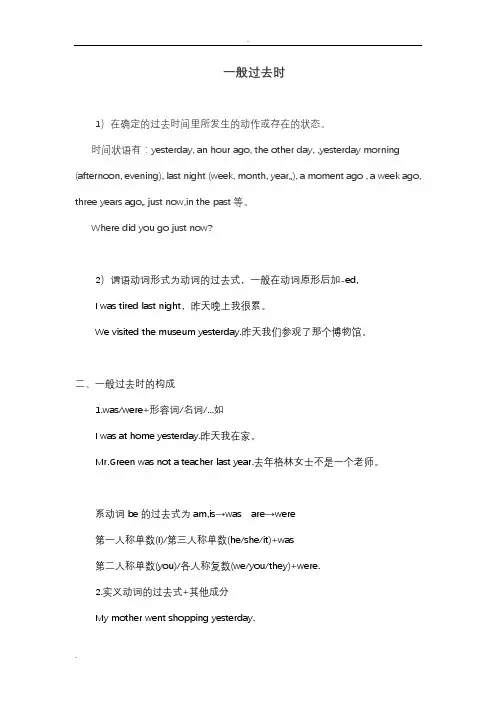
一般过去时1)在确定的过去时间里所发生的动作或存在的状态。
时间状语有:yesterday, an hour ago, the other day, ,yesterday morning (afternoon, evening), last night (week, month, year…), a moment ago , a week ago, three years ago… just now,in the past等。
Where did you go just now?2)谓语动词形式为动词的过去式,一般在动词原形后加-ed,I was tired last night,昨天晚上我很累。
We visited the museum yesterday.昨天我们参观了那个博物馆。
二、一般过去时的构成1.was/were+形容词/名词/...如I was at home yesterday.昨天我在家。
Mr.Green was not a teacher last year.去年格林女士不是一个老师。
系动词be的过去式为am,is→was are→were第一人称单数(I)/第三人称单数(he/she/it)+was第二人称单数(you)/各人称复数(we/you/they)+were.2.实义动词的过去式+其他成分My mother went shopping yesterday.我妈妈昨天去购物了。
His uncle worked in Beijing in 2014.他叔叔2014年在北京工作。
三、一般过去时的句式四、动词过去式的变化规则3 used toused to + do:"过去常常"表示过去习惯性的动作或状态,但如今已不存在。
Mother used to take a walk. (过去常常散步)二、构成及变化1. Be动词在一般过去时中的变化:am 和is在一般过去时中变为was。
(完整版)初中一般过去时详细讲解与练习
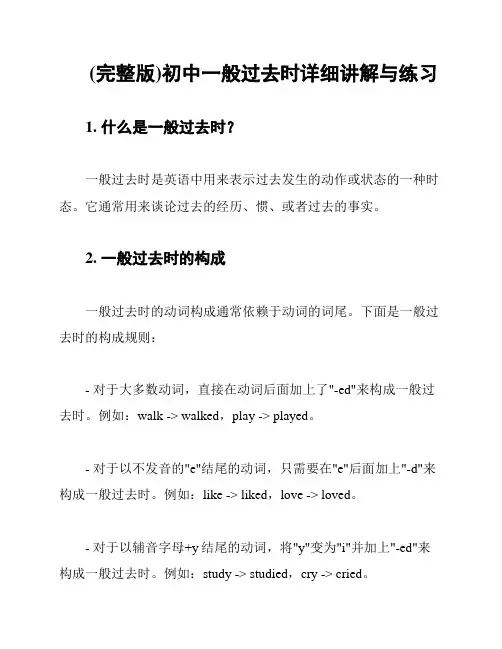
(完整版)初中一般过去时详细讲解与练习1. 什么是一般过去时?一般过去时是英语中用来表示过去发生的动作或状态的一种时态。
它通常用来谈论过去的经历、惯、或者过去的事实。
2. 一般过去时的构成一般过去时的动词构成通常依赖于动词的词尾。
下面是一般过去时的构成规则:- 对于大多数动词,直接在动词后面加上了"-ed"来构成一般过去时。
例如:walk -> walked,play -> played。
- 对于以不发音的"e"结尾的动词,只需要在"e"后面加上"-d"来构成一般过去时。
例如:like -> liked,love -> loved。
- 对于以辅音字母+y结尾的动词,将"y"变为"i"并加上"-ed"来构成一般过去时。
例如:study -> studied,cry -> cried。
- 部分动词的一般过去时需要进行不规则变化。
例如:go -> went,eat -> ate。
3. 一般过去时的用法一般过去时通常用来描述以下情况:- 过去发生的动作:I walked to school yesterday.- 过去的经历:He lived in London for five years.- 过去的事实:She was a teacher in the past.4. 一般过去时的句型练下面是一些练,帮助加深对一般过去时的理解和运用:1. 请用一般过去时填空:Yesterday, I ________ (watch) a movie at home.2. 完成句子:He _____ (visit) his grandparents last summer.3. 改写句子,使用一般过去时:I read a book yesterday. (改为否定句)4. 改写句子,使用一般过去时:They played basketball in the park. (改为疑问句)5. 总结一般过去时是用来表示过去发生的动作或状态的一种时态。
一般过去时讲解和练习forGrade5
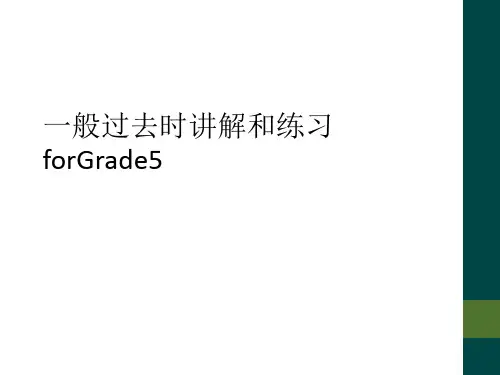
规则过去式ed的发音:
1. 在清辅音/p/, /k/, /f/ ,/s/ 等后加ed读清辅音 /t/ : asked cooked worked looked
talked helped
2. 在浊辅音及元音后加ed读浊辅音/d/ :
lived listened closed opened played
say—said: The teacher said,”look at the picture!” do—did: Simon did exercises in the morning. eat---ate: He ate a ice cream after class. come—came: The sun came down. go---went: Pupils went home after school. teach---taught: She taught us English last year.
一般过去时讲解和练习 forGrade5
1. 一般过去时用来描述在过去发生的动作或 存在的状态。 例如: It was Daming’s birthday yesterday. I bought you this book.
一般过去时的句子里常常有一个表示过 去时间的状语,如:
yesterday , last night (Sunday),at the weekend,in
We visited Big Ben and the London Eye. 否定句: We didn’t visit Big Ben and the London Eye. 一般疑问句: Did you visit Big Ben and the London Eye?
改写句子:
人教版八年级上册一般过去时语法讲解及练习(含答案)
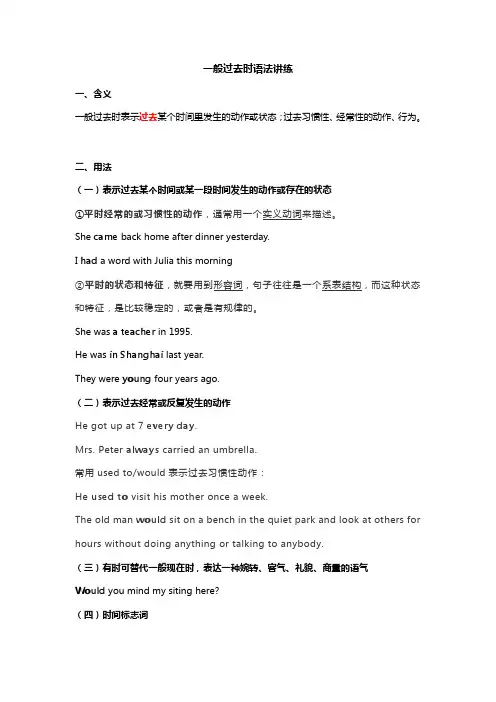
一般过去时语法讲练一、含义一般过去时表示过去某个时间里发生的动作或状态;过去习惯性、经常性的动作、行为。
二、用法(一)表示过去某个时间或某一段时间发生的动作或存在的状态①平时经常的或习惯性的动作,通常用一个实义动词来描述。
She came back home after dinner yesterday.I had a word with Julia this morningHe was in Shanghai last year.They were young four years ago.(二)表示过去经常或反复发生的动作He got up at 7 every day.Mrs. Peter always carried an umbrella.常用used to/would表示过去习惯性动作:He used to visit his mother once a week.The old man would sit on a bench in the quiet park and look at others for hours without doing anything or talking to anybody.(三)有时可替代一般现在时,表达一种婉转、客气、礼貌、商量的语气Would you mind my siting here?(四)时间标志词yesterday, the day before yesterday, last week/year/summer , two/three/days/weeks ago, that morning/winter/day/year, those days/years, at that time/moment, in 1990, just now, in the old days, two hours later, one day, when I was …years old/when I was young…三、句型结构(一)be动词四、动词过去式(过去式)的变化规则(一)直接加edlisten-listened visit-visited walk-walked(二)以e结尾,直接加dlive-lived hope-hoped(三)以辅音字母加y结尾的动词,变y为i加edcarry-carried study-studied(四)以重读闭音节结尾,如末尾只有一个辅音字母,双写辅音字母加edshop-shopped stop-stopped drop-dropped plan-planned fit-fitted prefer-preferredI lived ( live )in Shanghai in 2003.(五)不规则动词过去式的变化需特殊记忆buy-bought go-went read-readI read (read) English yesterday morning.【注意事项】1、一般过去时只说明过去的事情,不强调动作对现在的影响。
超详细一般过去时的全面讲解【附练习与答案】
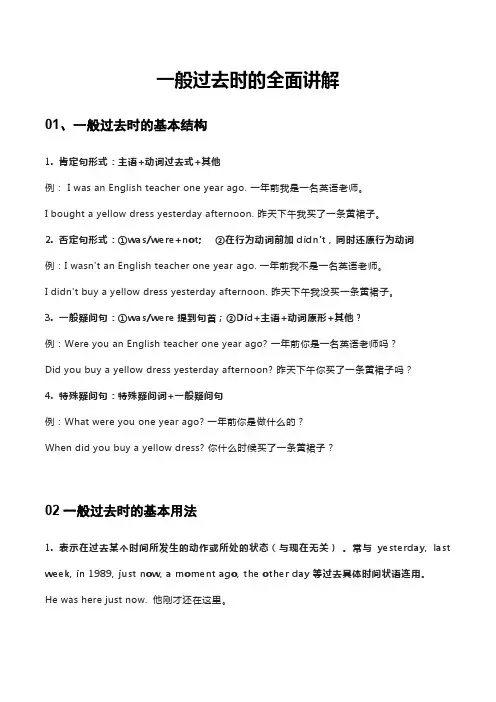
一般过去时的全面讲解01、一般过去时的基本结构1. 肯定句形式:主语+动词过去式+其他例: I was an English teacher one year ago. 一年前我是一名英语老师。
I bought a yellow dress yesterday afternoon. 昨天下午我买了一条黄裙子。
2. 否定句形式:①was/were+not; ②在行为动词前加didn't,同时还原行为动词例:I wasn't an English teacher one year ago. 一年前我不是一名英语老师。
I didn't buy a yellow dress yesterday afternoon. 昨天下午我没买一条黄裙子。
3. 一般疑问句:①was/were提到句首;②Did+主语+动词原形+其他?例:Were you an English teacher one year ago? 一年前你是一名英语老师吗?Did you buy a yellow dress yesterday afternoon? 昨天下午你买了一条黄裙子吗?4. 特殊疑问句:特殊疑问词+一般疑问句例:What were you one year ago? 一年前你是做什么的?When did you buy a yellow dress? 你什么时候买了一条黄裙子?02一般过去时的基本用法1. 表示在过去某个时间所发生的动作或所处的状态(与现在无关)。
常与yesterday, last week, in 1989, just now, a moment ago, the other day等过去具体时间状语连用。
He was here just now. 他刚才还在这里。
What did you do yesterday? 你昨天做了什么事?2. 在过去一段时间内的经常性或习惯性动作。
一般过去时讲解及练习含答案

一般过去时一、一般过去时的定义一般过去时表示过去某一时候或某一段时间所发生了的事情或存在的状态。
常与过去时间yesterday, this morning, just now, a moment ago, in May, last night / year / week, once upon a time, the other day, before …, when – clause, in the past连用。
如:What did you do yesterday 昨天你干了什么?I met Lin Tao this morning. 今天上午我会到了林涛。
I was there a moment ago. 刚才我在那儿二、用法说明1表示在过去某个时间所发生的动作或所处的状态。
常与yesterday, last week, in 1989, just now, a moment ago, the other day等连用。
如:He was here just now. 他刚才还在这里。
What did you do yesterday 你昨天做了什么事?2在过去一段时间内的经常性或习惯性动作。
如:We often played together when we were children. 我们小时候常在一起玩。
注:表示过去经常发生的动作还可用used to 和would。
如:He used to smoke a lot, but he doesn’t now. 他过去经常抽烟,但现在不抽了。
Whenever we were in trouble, he would help us. 每当我们遇到困难,他都会帮助我们。
3表示主语过去的特征或性格。
如:At that time she was very good at English. 那时她英语学得很好。
4用在状语从句中表示过去将来。
如:He said he would wait until they came back.5一般过去时有时可以表示现在,多与want, hope, wonder, think, intend 等动词连用,使语气更委婉。
初中英语主要时态系列:一般过去时(讲解+练习)
初中英语主要时态系列:一般过去时(讲解+练习)一般过去时是初二学到的语法内容,在中考中占有及其重要的地位。
今天给大家带来了关于一般过去时的全面解析,好好学哟!一般过去式定义1、表示过去某个时间发生的动作或存在的状态,常和表示过去的时间状语连用,如yesterday, last night, in 1990, two days ago等。
如:I got up at 6:30 yesterday.我昨天6:30起床。
【动作】She was at home last night.她昨天晚上在家。
【状态】在英语语法中,“时“指动作发生的时间,”态“指动作的样子和状态。
2、表示过去经常或反复发生的动作,常和often, always等表示频度的时间状语连用。
如:He always went to work by bus last year.去年他一直乘公共汽车上班。
判断标志1. 与ago连用的时间状语如:a moment ago, two minutes ago, six months ago, one week ago… 等We were primary students 5 years ago.五年前我们是小学生。
2. 与last 连用的时间状语last week, last year, last month, last day…He suddenly fell ill last night.他昨晚突然病倒了。
3. 与 yesterday 连用的时间状语yesterday morning, yesterday morning …We weren\'t late yesterday. 我们昨天没迟到.※the day befo re yesterday 昨天4. 与 one 连用的时间状语one morning 某个早上, one evening 某个夜晚5. 与that连用的时间状语that day, that morning, that year…6. 其他时间状语just now 刚刚 in the old days 在过去in 1980 at that time在那时构成含有be动词的一般过去时的主结构:主语+was/were+表语1、肯定句:主语+was/were+表语。
(完整版)高中一般过去时详细讲解与练习
(完整版)高中一般过去时详细讲解与练习一般过去时的用法一般过去时用来描述过去发生的动作或状态,表示在过去某个时间点或一段时间内发生的事件。
在英语中,一般过去时通常由动词的过去式来表示。
一般过去时的用法如下:1. 表示过去某个时间点的动作或状态:- I went to the park yesterday. (我昨天去了公园。
)- She lived in London in 2010. (她在2010年住在伦敦。
)2. 表示过去一段时间内的动作或状态:- They studied English for three hours. (他们研究英语三个小时。
) - We played soccer every weekend. (我们每个周末都踢足球。
)一般过去时的构成一般过去时通常由动词的过去式构成。
对于大多数动词,过去式是在动词原形后加上"-ed"形成的。
但是也有一些不规则动词的过去式需要单独记忆。
一般过去时的构成如下:- 对于一般动词:动词原形 + "-ed"- 对于以不发音的"e"结尾的动词:动词原形 + "d"- 对于以辅音字母加"y"结尾的动词:去掉"y",加上"ied"- 对于不规则动词:需要单独记忆,没有统一的规则一般过去时的练以下是一些练,帮助你巩固一般过去时的用法和构成:1. 用适当的动词的过去式填空:- She __________ (buy) a new car last week.- We ___________ (visit) our grandparents yesterday.- They ___________ (play) tennis in the evening.2. 改写下列句子,使用一般过去时表达相同的意思:- I am busy now. -> I ________ busy yesterday.- They live in New York. -> They ________ in New York last year.3. 根据给定的情景填写适当的动词的过去式:- Yesterday, John ___________ (watch) a movie at home.- Last summer, we ___________ (go) to the beach for vacation.。
一般过去时详细讲解与练习
一般过去时讲解与练习一、概念:表示过去时间里发生的动作或存在的状态,或者过去习惯性、经常性的动作。
*句中一般有以下时间状语:1.时间+ago:a moment ago片刻之前;two minutes ago两分钟前;three hours ago三个小时前;fivedays ago五天前;one week ago一周前;six months ago六个月前,four years ago四年前st+时间last time上一次last night昨天晚上last week上个星期last month上个月last term 上个学期last Monday上周一last year去年3. yesterday+时间yesterday morning 昨天早上yesterday afternoon 昨天下午yesterday evening昨天晚上the day before yesterday前天the day before yesterday in the morning前天早上4. one +时间one day有一天one morning一天早上one evening一天晚上one Monday afternoon 一个星期一的下午5.其他时间状语just now刚才once upon a time很久以前in 1980在1980年时the other day 几天前at that time在那时二、基本结构:①主语+谓语(动词过去时)+句子其他成分②主语+was/were+形容词/名词/介词短语+过去时间。
三、主语+谓语(动词过去时)+句子其他成分的句型变化:1.肯定句: I worked in that hospital last year. 我去年在那家医院上班。
2.否定句: I didn’t work in that hospital last year.3.一般疑问句:Did you work in that hospital last year?4.肯定和否定回答: Yes, I did. No, I didn’t.四、主语+was/were+形容词/名词/介词短语+过去时间的句型变化1.肯定句: I was fat three years ago. 我三年前很胖。
小学英语一般过去时专项讲解、练习和参考答案
小学英语一般过去时专项讲解、练习和参考答案一般过去时专项讲解与练习一、概念:一般过去时表示过去某一时候发生的动作或存在的状态。
常与一般过去时连用的时间状语有:yesterday; 昨天just now刚才the day before yesterday;前天⋯⋯ago ⋯⋯之前(例如:三天前 three days ago )Last ⋯⋯上一个⋯(例如:上周星期天last Sunday )in 1990在1990年(in+过去时间)二、分类(一) be 动词的一般过去时:肯定句:主语 +be 动词的一般过去时( was/were)否定句:主语+be动词的一般过去时(was/were)+not一般疑问句: be 动词的一般过去时( was/were )+主语(二) there be结构的一般过去时与be 动词的一般过去时的变化基本一致。
(三)一般动词的过去时:肯定句:主语 +动词的过去时( I laughed.)否定句:主语 +did not+ 动词原形( I didn’t laugh.)一般疑问句: Did+主语 +动词原形( Did you laugh?)三.巧记 chant动词一般过去时,表示过去发生事;be 用 was 或用 were, have,has变had;谓语动词过去式,过去时间坐标志;一般动词加 -ed ,若是特殊得硬记。
否定句很简单,主语之后didn ’ t 添;疑问句也不难, did 放在主语前;如果谓语之前有 did ,谓语动词需还原;动词若是 was,were, 否定就把 not 添。
四、习题练习(一)用动词的适当形式填空:1.He ______ (work) in that bank four years ago.2.She ______ (live) in the US last Monday.3.I ______ (see) him yesterday.4.He _______(come) to school at 6 o’clock this morning.5.The boy _______ (have) a bad cold yesterday.6.When _______ you _______ (buy) that house?7.He _______(tell) a story to his daughter yesterday.8._____ you ____ (try) to call me last night?9.What _______you _______ (buy) in the shop?I ______ (buy) a coat just now.10. The doctor ______ (get) up late this morning.11.She ________ (paint) the wall last month.12.My mother _______ (be) a worker 20 years ago.13.________ (be) you here just now?No, I ________ (be not) here.14.Why _______ your brother _______ (cry) last night?15.It ______(be) my mother’s birthday yesterday.(二)翻译下列句子:1.我上周去看爷爷和奶奶了。
- 1、下载文档前请自行甄别文档内容的完整性,平台不提供额外的编辑、内容补充、找答案等附加服务。
- 2、"仅部分预览"的文档,不可在线预览部分如存在完整性等问题,可反馈申请退款(可完整预览的文档不适用该条件!)。
- 3、如文档侵犯您的权益,请联系客服反馈,我们会尽快为您处理(人工客服工作时间:9:00-18:30)。
一般过去时讲解与练习一般过去时一般过去时(simple past tense) 表示过去某个时间里发生的动作或状态;过去习惯性、经常性的动作、行为;主语在过去所具备的能力和性格等。
一、一般过去时的形式1.be动词的一般过去时态的形式有两种,即was, were。
amBe is was :主语是第一、第三人称单数are were:主语是复数,第二人称单、复数2.助动词、情态动词、行为动词的一般过去时态的形式没有人称和数的变化。
二、一般过去时的用法1. 表示过去某个特定时间发生的动作或存在的状态这种情况常与“just now刚才,yesterday昨天,last year去年,in 1999在1999年,two days ago两天之前”等表示过去的时间状语连用。
She suddenly fell ill yesterday.78 她昨天突然病倒了。
We didn't have classes last week. 上周我们没有上课。
• 一般过去时亦可与“today今天,this week这周,this month这个月,this year今年”等表示现阶段时间状语连用。
如:Did you meet him today? 今天你看见他了吗?2. 表示过去的习惯性或经常发生的动作一般过去时表示过去经常或反复发生的动作,常和“often经常,always总是,once a week一周一次”等表示频度的时间状语连用。
I went to the cinema once a week when I was at school. 我上学时每周去看一场电影。
When I was in the countryside, I often walked by the riverside. 我在乡下时经常在河边散步。
• 表示过去一段时间内经常或反复发生的动作,也可以用would+动词原形或用used to加动词原形:When he was young, he would go skating every winter. 他年轻时每年冬天都要去滑冰。
Mrs Smith used to have a big house in down town. 史密斯夫人在城里曾经有一座大房子。
3. 在条件、时间状语从句中代替一般过去将来时He said he would let me know as soon as he got there. 他说只要他一到达那儿就马上让我知道。
He said he would not go if it rained. 他说如果下雨他就不去。
4. 用于虚拟语气If only I were a bird. 要是我是只鸟儿就好了。
(表示不可能)Did you wish to see me? 你是找我吗?(表示委婉)三、一般过去时的时间状语1.由副词yesterday或由yesterday开头构成的短语:yesterday morning/ afternoon等。
如:Where did you go yesterday? 昨天你去哪儿了?2.由“last+表时间的名词”构成的短语:last week, last year等。
如:I received two letters from my home last month. 上个月我收到两封家信。
3.由“时间段+ago”构成的短语:a moment ago, an hour ago等。
如:They left two hours ago. 他们两小时以前离开了。
4.由“介词+时间名词”构成的短语:in 1998, on Monday, on April 12等。
如:Napoleon did in 1821. 拿破仑死于1821年。
5.其它词或词组:then, just now等。
如:The scientists lived in China then. 当时这些科学家住在中国。
动词变化规则动词一般过去时的变化规则:1.直接+ed: work—worked look—looked play—played,2.以不发音的e结尾,直接+d: live—lived hope—hoped use—used,3.以辅音字母+y结尾,变y为i+ed: study—studied carry—carried worry—worried, 4.以元音字母+y结尾,直接+ed: enjoy—enjoyed play—played5.以重读闭音节结尾,双写最后的辅音字母+ed: stop—stopped plan—planned6.不规则变化:is/am—was are—were begin—began blow—blew bring—brought一般过去时的句子结构:陈述句:主语 + 动词过去式 + 其他例:I was 11 years old last year.He swam at school yesterday.否定句:①was/were + not 例:I wasn’t 11 years old last year.②didn't + 行为动词原形 He didn’t swim at school yesterday.一般疑问句:①Was/Were + 主语 + 其他?例:Were you 11 years old last year?②Did + 主语 + 行为动词原形 + 其他?Did he swim at school yesterday? 一般过去时的口诀:一般过去时并不难,过去动作、状态记心间。
动词要用过去式,时间状语句末站。
否定句很简单,didn't 站在动原前,其它部分不要变。
一般疑问句也好变,did放在句子前,主语、动原、其它部分依次站。
特殊疑问句也简单,疑问词加一般疑问句记心间。
最后一条请注意,动词过去式要牢记!一般过去时态的“三变”技巧一变:肯定句变为否定句【技巧1】句中含有情态动词或助动词could,would,should等时,可直接在其后面加not构成否定句。
例如:I could get you a concert ticket. → I could not / couldn't get you a concert ticket.【技巧2】句中含有系动词was,were 时,可直接在其后加not构成否定句。
例如: I was at home when you called me. → I was not / wasn't at home when you called me.【技巧3】句中谓语是行为动词时,在该动词之前加did not / didn't,动词原形,构成否定句。
例如: The singer sang some Chinese songs. → The singer did not / didn't sing any Chinese songs.二变:陈述句变为一般疑问句【技巧1】移结构动词至句首,was,were, could,would,should等移到句首。
例如:He could pack his things himself. → Could he pack his things himself?【技巧2】添加助动词did。
谓语是除情态动词、助动词、系动词以外的实意动词时,在主语之前加did,实意动词还原。
例如: Mr Li looked very o ld. → Did Mr Li look very old?三变:陈述句变为特殊疑问句【技巧1】确定疑问词:人who / whom,物what,地点where,时间when / what time,原因why,方式 how,频率how often,长度how long,距离how far等等。
例如:They gave the concert last night. → When did they give the concert?【技巧2】辨认结构形式:疑问词+情态动词/助动词/ was / were / did + 主语 + ...?例如:The accident happened near the station. → Where did the accident happen例题解析:1. Mr. Mott is out. But he ______ here a few minutes ago.A. wasB. isC. will beD. would be解析:几分钟前发生的动作,应该用一般过去时。
应选 A,2. ---Hi,Tom.---Hello,Fancy. I ______ you were here.A.don't knowB. won't thinkC.thinkD. didn't know解析:虽然句中没有明确的时间状语,但是可以通过上下文语境判断出,我说这话之前不知道,但是现在知道了,表示过去的动作,要用过去时态。
所以选D。
3.He promised to tell me by himself when I ______.A. comeB. would comeC. cameD. had come解析:在时间状语从句中,用一般过去时表示过去将来。
应选C。
小学常用不规则动词过去式原形过去式中文am/is was 是(表示存在、状态等)are were 是(表示存在、状态等)become became 成为;变成begin began 开始break broke 打破bring brought 拿来;取来;带来build built 构筑;建造;建筑buy bought 购买;买can could 可以;能;可能;会catch caught 赶上(车船等);捕获come came 来;来到cut cut 切;割;削;剪do/does did 做;干;行动draw drew 画drink drank 喝;饮drive drove 开车;驾驶eat ate 吃feel felt 感到;觉得find found 寻找;查找fly flew 飞行forget forgot 忘记;忘却get got 变得give gave 给;授予go went 去have/has had 得(病);患(病);有;吃;饮hear heard 听见;听说hide hid 隐藏is was 是(表示存在、状态等)keep kept 保持;使保持某种状态know knew 知道;了解leave left 离去;出发let let 允许;让lose lost 失去;丧失make made 使;促使;迫使;做;制作may might 可能;可以mean meant 表示……的意思;作……的解释meet met 遇见;相逢put put 放;摆;装read read /e/ 读;阅读ride rode 骑ring rang (铃)响rise rose 上升run ran 跑;奔跑say said /e/ 说;讲see saw 看见send sent 发送;寄;派;遣set set 放, 置show showed 出示;给……看shut shut 关上(门、盖、窗户等)sing sang 唱;唱歌sit sat 坐sleep slept 睡;睡觉speak spoke 说;说话swim swam 游泳take took 搭乘;花费(时间);拿走;带到teach taught 教;讲授tell told 告诉;讲述think thought 想;思考will would 将要win won 赢;获胜write wrote 书写一般过去时练习题一、单项选择: (10)( )1. My father______ill yesterday.A. isn't B. aren't C. wasn't D. weren't( )2.______your parents at home last week﹖A. Is B. Was C. Are D. Were( )3. The twins______in Dalian last year. They______here now. A. are; were B. were; are C. was; are D. were; was( )4.______your father at work the day_____yesterday(前天)﹖A. Was; before B. Is; before C. Was; after D. Is; after( )5.—Who was on duty last Friday﹖—______.A. I am B. I was C. Yes, I was D. No, I wasn't( )6. I cleaned my classroom ___________.A with three hoursB three hours agoC in three hoursD three hours before( ) 7. I came _______ my house two days ago .A back onB back toC to backD back( ) 8 . ___________? He did some reading at home.A What does your father do yesterday eveningB What does your brother do in the schoolC What did your brother do over the weekendD Where did your brother go last Sunday( ) 9. What did you do ________ ? I went to the movies.A next morningB over the weekendC in the weekendD next Monday ( ) 10. The koala sleeps _______,but gets up _________.A during the day; at the eveningB at day ;during nightC in the day ;during the eveningD during the day ; at night二、请用动词的正确形式填空。
